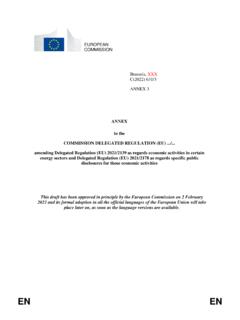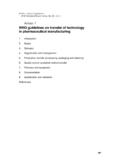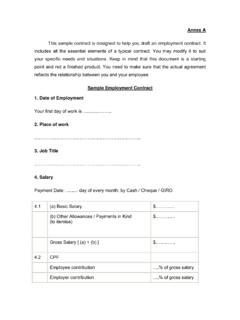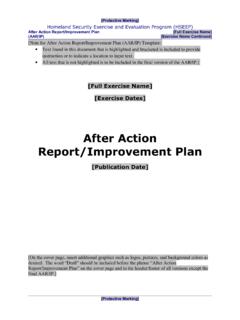Transcription of Annex 7 Methods of Measuring Economy Efficiency and ...
1 1 | P a g e Methods Of Measuring The Economy , Efficiency And Effectiveness Of Public Expenditure Annex 7: August 2015 2 | P a g e TABLE OF CONTENTS 1 Introduction .. 3 2 PER Context .. 3 3 Necessity of the measures .. 4 4 Measurement and coding .. 5 5 Assumptions .. 5 6 Definitions and basic qualitative measures .. 6 Measuring Efficiency with DEA .. 9 DEA .. 10 Assumption of DEA .. 10 Scale Efficiency Issues in DEA .. 16 Using Software to Do the Estimates .. 19 Scale Efficiency .. 23 Limitations of DEA .. 27 Stochastic Frontier Analysis .. 27 7. What to Do if No Financial 30 LIST OF TABLES Table 1: Baseline social perspectives of the PER.
2 3 Table 2: Baseline economic data for the PER .. 4 Table 3: Integrated measure of Economy , Efficiency and Effectiveness .. 8 Table 4: Data for Illustration of DEA Rankings .. 11 Table 5: Illustrative Data for DEA with Potential for Scale 16 LIST OF FIGURES Figure 1: Input Output Data Illustrated .. 12 Figure 2: Illustration of Potential for Scale Efficiency .. 24 Figure 3: Example of Normal and Half-Normal Distribution of Error .. 28 3 | P a g e 1 Introduction The PER normally seeks to facilitate and improve the implementation of the medium term effort to strengthen budget management, in terms of such predictability, Efficiency and sustainability.
3 It therefore evaluates budget performance against the approved allocation framework, costs, output, and outcome goals. The purpose is to determine whether funds are being spent according to plans and whether the spending units achieved the intended objectives. This Annex documents a set of Methods used to measure the Economy , Efficiency , and effectiveness of expenditure in the context of a PER. In considering Efficiency , both technical and scale Efficiency will be considered. Technical Efficiency refers to the ratio of actual to potential output of the spending unit.
4 Scale Efficiency refers to the extent to which the spending unit takes advantage of opportunities to grow its output faster than it can grow its inputs, assuming the latter is growing at some fixed rate. The note motivates the measurement Methods with the policy context of the PER, the baseline data needed, the necessity of the measures, the importance of proper coding of allocations, and background assumptions. Then, the various measurement Methods are presented. Among the Methods considered are DEA and stochastic frontier analysis. Additional assumptions are indicated in context.
5 2 PER Context The PER normally includes background information to support interpretation of the measures. Table 1 provides an indication of the general social development information and perspectives of the evaluation. Table 1: Baseline social perspectives of the PER Indicators Baseline social perspectives of the PER Poverty and unemployment indicators, defining the social development challenge. Such as: Access to infrastructure / services (such as water / roads / energy / sanitation) adequacy measures Health indicators and poverty measures Education indicators and poverty measures Aggregate poverty and unemployment assessments.
6 The statement of development imperatives for the next 3-5 years. Such as: Reducing poverty Increasing equity The specific numerical targets that define the development objectives. Such as 60% improvement in education measures over 3 years 50% improvement in health indicators over 5 years 80% reduction in disguised unemployment over 5 years Annual targets and costs. Such as 20% improvement in education measures; Cost $50 million. 10% improvement in health indicators; Cost $80 million. 16% reduction in disguised unemployment; Cost $100 million. 4 | P a g e Table 2 provides an indication of the baseline economic data and perspectives of the PER.
7 Table 2: Baseline economic data for the PER Indicators Economic data for perspectives of the PER Economic perspectives for the PER Economic activity, by industrial and economic classifications. Industrial sectors Demand categories: o Consumption; o Investment; o exports; o imports; o government budget Such as 2% annual growth of sector outputs 3% growth of exports 2% growth of effective consumption per dollar of imports Economic infrastructure, Water, minimum thresholds to be met and demand profiles Sanitation, minimum thresholds to be met and demand profiles Roads, minimum thresholds to be met and demand profiles Energy/electricity, minimum thresholds to be met and demand profiles Such as 60% increase of customers with adequate water supply.
8 3 years, $100 million 50% improvement in sanitation indicators over 5 years; $80 million 80% increase in customers with adequate electricity supply over 5 years; $66 million Employment Distribution by Industry Employment status Gender. Location Such as: 95% employment rate in 4 years; $150 million Gender equity in pay and working conditions over 3 years; $100 million 6% growth in rural employment over 5 years Budget profile In terms of Revenue Expenditure - recurrent expenditure and capital expenditure; wages, emoluments; materials and minor equipment; goods and services; transfers and gifts Budget balance Such as Balanced budget Increase in the share of minor equipment and materials to 5% or more of budget Reduction of the share of transfers and gifts to 15% of budget while achieving poverty targets.
9 20% increase in number of persons graduating from springboard programs to full employment; Cost $100 million 3 Necessity of the measures The measures of Economy , Efficiency and effectiveness are necessary to assess the productivity of resource use in government. Government spends its resources to deliver infrastructure and services to the population, and to encourage community development. As one of the largest spenders of national resources, it is on a continuous search for ways to prioritise budget allocations in a way that improves the relationship between expenditures inputs, actions, outputs, and their outcomes.
10 In market operations, the prices of output can be used to value them, define the profit, and specify allocations guided by elegant calculations. However, no suitable market prices are available to value the outputs produced by government. One alternative is to use the Methods identified in this Annex . The Methods take account of the importance of public involvement in the planning, implementation and review of expenditures to deliver infrastructure and services. 5 | P a g e 4 Measurement and coding Activity and input analysis of each allocation is the foundation of the PER.














